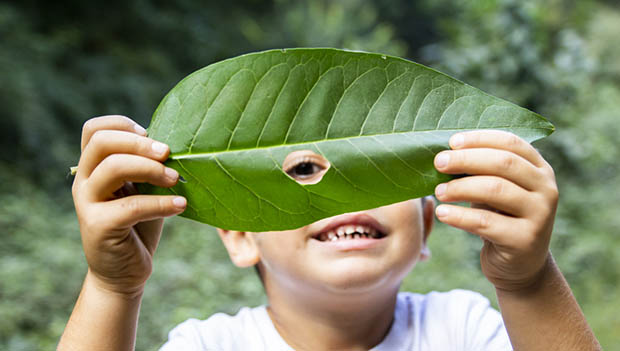
Familiarizing your kids with the diversity in plant life right outside your door doesn't have to begin with formal scientific names and descriptions. In fact, building up to a point where your child might find a genuine interest in knowing the different genus and species names of a plant is much more authentic, and it starts with simple, daily observations—tuning their eye to the range of plant life around them.
Is the plant woody or herbaceous? What makes one leaf shape different from the next? How does the plant physically change from one day to the next? Do some change more than others? How does the surrounding animal life interact with the plant?
You'll find that once you and your kids head outside and start asking questions, it'll be hard to stop! At some point you'll likely want to go out and find a good field guide for your area (as questions you don't know the answers to are likely to come up quick), but you don't need one to get started with simply noticing the unique plant characteristics right outside your door.
While winter may not be the first season that comes to mind when someone mentions plant identification and observation, plants don't disappear in the winter—they still surround us. In fact, to be able to identify some plants, it helps to notice the way they change from each season to the next.
From leaf shape and bark type to flowering or non-flowering plants, there's endless play in watching, noticing and ultimately understanding the greenery that surrounds us. Helping kids see these details will not only help them continue to wonder and learn, but also stay safe (away from the poisonous plants) and fulfilled enjoying the outdoors.
Pick a Place
A local park, your neighborhood common area, a bench in a shopping center, a wilderness hike and the garden section at a local store are vastly different and yet all great places to start a plant identification journey with your young observer. The trick to getting started is to find a place that's convenient and engaging! To make it easier to commit to observations routinely over a long period of time (to track changes), pick a place nearby that you'll be able to easily visit on a regular basis.
Designate a Notebook
Describe, draw, take pictures—help your child take ownership in their observations by providing a space to jot down their thoughts. Whether you consider it a "science observation notebook" or a "nature journal" of sorts, the point here is for them to record what they see. This will help them track changes over time and have notes to compare things to when they see something again (or get around to comparing notes with a more formal field guide)!
Having them write things down will help them start to notice similarities and differences on their own, eventually pointing out plants you've identified with a certain name or category in places other than your designated starting space.
Emphasizing Sight and Sound for Safety
Plant observation should be limited to the senses of sight and sound before you know with certainty it's safe to touch. It won't take long before simply eyeing the plants and surroundings won't do anymore, and they'll want to incorporate the less-safe senses when it comes to interacting with unknown plants.
Make sure to carefully integrate the other senses into the observation experience, by limiting some (like taste and touch!) before actually looking up the plant in a field guide to be sure of any potential toxin or risk.
Deciduous vs. Evergreen
Now, here's where the winter months come in. The easiest time to notice a deciduous tree versus an evergreen tree is in the winter. Once you and your kids are in your observation place with the materials you need to record what you see, it's time to start asking questions to narrow in on the diversity. Starting with the trees around you gives you a chance to break a type of plant life into one of two categories: those with leaves (evergreen) and those without leaves (deciduous).
Help your child count how many of each type surround you (and record their count in their book). From there, see if they have a favorite or if there's one that is particularly unique (or common) to look at more closely. Let your observations drive the inquiry! Just don't forget to make time to write things down as you hone in.
Seed Pods and Leaf Shapes
Narrowing in on specific trees and plants in your observation spot will begin to highlight details of growth on and around the plant. Use the journal to note safe-sense observations: things you see, hear and smell around the plant without touching or tasting it. If described well enough (or if you use photography), later you can look these plants up to see if they're safe to touch. Describe the shape, color and size of the seed, as well as if it's locked in a pod or individually identifiable.
With leaves, do the same—have your child draw the shape and find similarities and differences from one to the next. Noting these increasingly detailed similarities and differences lays a strong foundation in the field of plant identification.
Flowering or Non-flowering
Determining this during the winter months will likely lead to mere predictions—as flowers often show their colors in the spring and summer months. However, there are a significant number of winter-flowering trees and plants (including a number of fruit-bearing trees) in more inclement areas. Noticing what trees produce flowers in the winter months can help set the stage for the question of "why flowers?" moving forward.
Defense Mechanisms & Textures
Looking at the texture of plant leaves, stems, bark, seedpods and more is another clue into the identification of a plant. For example, the fuzzy or "hairy" leaves on a berry plant are one of the major ways to discern between the three-leaved berry plant or the three-leaved poison oak or poison ivy! This is yet another reason to carefully integrate the sense of touch after visual observation and field guide research.
Help your child look and ask, "How does this plant protect itself? Is it sending a warning in any way?" Record observations carefully—this is the practical part of plant identification and the first rule of safety for any young ones interested in exploring the great outdoors.
Looking Beyond Just Getting Started
There's so much to observe and so many questions to ask about the natural life that surrounds us, so you and your child might want to invest in a field guide to look up scientific names and additional details. This should be encouraged, but don't forget that getting started with plant identification in the winter months sometimes requires more patience as the diverse details of your surrounding plant life slowly come to life.
With spring just around the corner, your kids' winter plant identification observations will provide more context when witnessing some of the biggest changes of a plant's lifecycle in the coming months. Once hooked, plant identification fosters a lifelong love of learning and nature, so help your little one put together their favorite observation recording tools (notebooks, pencils and a camera if you have one), and find a spot to sit and enjoy!
READ THIS NEXT: 7 Inspiring Female Figures in Art and Science









Discuss This Article